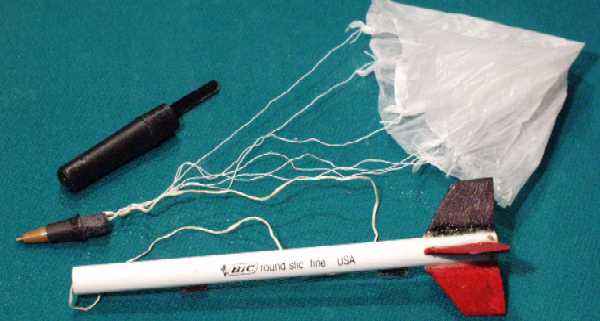
This is a fun little rocket that uses the tiny Quest MicroMaxx motors to loft a Bic(R) pen over 50' in the air and land by Parachute.
"Excuse me sir, but is that a rocket in your pocket?"

This is a fun little rocket that uses the tiny Quest MicroMaxx motors
to loft a Bic(R) pen over 50' in the air and land
by Parachute.
Design
History:
I wanted to design my own MicroMaxx powered rocket but couldn't find
a good material to use for a body tube. I was just getting ready
to roll my own tubes when I noticed that the pen I was holding was about
the right size. This particular brand of pen, the Bic(R)
"Round Stic(R)" has a 5mm inner diameter, and is a
perfect fit for the MicroMaxx motors. It is a bit heavy but is very
strong. As an added bonus, the other parts of the pen supply the
majority of the building materials for the rest of the rocket.
This rocket was designed and built in one evening and flown two days later.
The fin design was just off the top of my head and seemed like a good shape for maximum strength given the thin balsa. It is similar to a WAC Corporal shape although I chose to use four fins instead of the WAC's three. Later I realized that the rocket looked a lot like the HV ARCAS sounding rocket so I renamed this design the Bic(R) ARCAS.
It's first flight was on 10/22/00 with near-perfect results and great chute deployment but the sewing-thread shock cord failed.
The next flight, with new and improved kevlar shock cord, was at the
Blaine, MN MASA
launch on 10/28/00 with perfect launch, flight, deployment, and recovery.
Parts: (click image
for closeup)
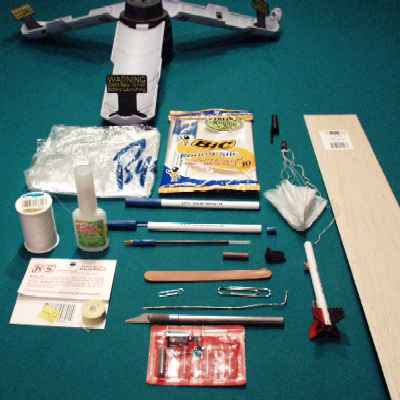
Tools/Supplies:
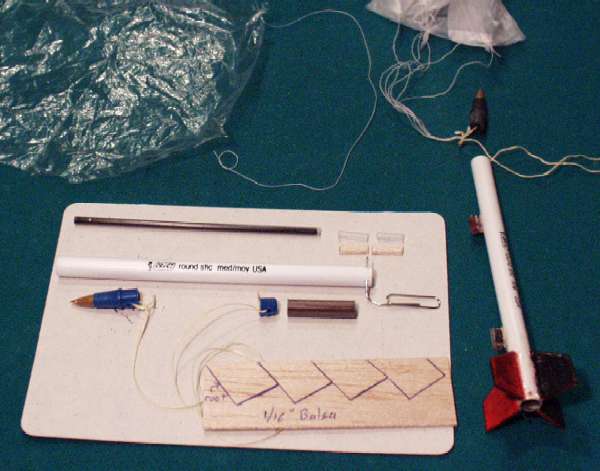
1. Disassemble pen:
a. Twist off tip w/attached ink tube (might
need pliars)
b. Carefully use fingernails or pocket knife
to extract end plug
(If it
won't come off, push it out with a stiff wire from the other end, or, in
stubborn cases,
cut off the last 1/8" of white tube and the end plug will come with it.)
This will be used
in step 5 to construct the motor thrust ring and shock cord attachment
poing.
c. Separate beige ball tip w/attached ink
tube from the colored cone-shaped grip
2. Nose cone:
a. Shorten the shoulder of the conical grip so that
only 3/8" of shoulder remains
(this will give more room for
the chute and make the nose cone eject more easily).
Cut it using a sharp razor knife
by rolling the cone under the knife against a table top (protected by cardboard!).
Save the remaining ring for use
as the motor thrust ring in step 5 if the end plug was not salvagable from
step 1.
b. Note: this step can be messy: Cut off
the ink tube from the tip, leaving about 1/4" so the pen still has some
ink left to write with.
(Yes, this will remain a
functional pen to use for filling out your flight cards!)
c. Plug end of ink tube that is still attached to
the tip with a spike of tissue and soak the tissue with CA glue.
Spray it with CA accellerator/kicker
if you have some. This should keep it from leaking.
d. Cut off and save the clear part of the remaining
ink tube and carefully discard the ink-filled portion.
e. Drill small 1/16" hole in middle of shoulder
of cone using knife tip or drill bit.
f. Carve small groove from hole to end of shoulder
so shock cord will not be pinched.
g. File or sand shoulder of cone until it EASILY
slides in and out of body tube
h. Reinstall the pen tip into the grip.
3. Mark body tube for fins and launch lugs:
a. Mark the fin alignment lines on the body tube.
1. Hold the pen so you are looking at
the aft end. Use a pencil to mark
three equally spaced
120 degree marks on the end edge of the body tube.
2. Lay the tube on a flat table, lay
a pencil on the table perpendicular to the
body tube.
3. Rotate the body tube until an alignment
mark lines up with the pencil tip
4. Slide the pencil on along the aft
2" of the body tube to make the fin
alignment line.
5. Rotate the body tube 120deg and make
another line. repeat for 3rd fin.
b. Using the same technique, mark the launch lug
attachment point line on the body
tube between two fin
lines. this line should extend from the aft end of the
tube to a bit forward
of the mid-point.
4. Build motor retainer clip:
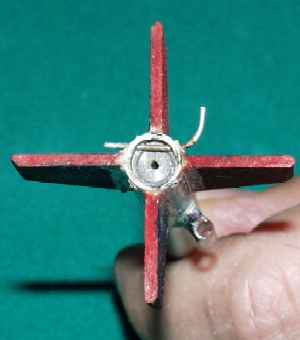
a. Use tip of razor knife, or small drill
bit to make two 1/32" holes each 1/16"
from the aft end of
the body tube and spaced 90 degrees apart, on opposite
sides of a fin line,
opposite of launch lug.
b. Cut a 3/4" piece of normal paper clip wire,
bend the last 1/4" up into an L shape
c. Holding the clip by the short leg of the
L, insert the long leg through the two
holes. It may
take some wiggling to get the holes angled so the clip will
pass between them.
The fit should be firm enough so that the clip will not
fall out on its own,
yet can be inserted and removed fairly easily.
d. Make sure the wire is far enough off to
the side so it will not cross the nozzel
area of the motor.
If it is too close, try again on another part of the tube.
The wire only needs
to cover a small area of the motor in order to prevent the
ejection charge from
blowing the motor out of the rocket.
e. Remove retainer wire for next step.
5. Build and install motor thrust ring/shock cord attachment
ring:
a. Cut a 1/4" cylindrical section from the
pen end plug, discard flat part of the plug.
(If unable to
get a good piece, use the remainder cut from the nose cone in step 2)
b. Make 1/16" hole in side of ring
c. Make small groove from hole to one edge
of ring
d. Insert Kevlar thread into hole and tie
securely (bowline or square knott) leaving
a 1/4" loop so the
knot will not interfere with fit of ring.
e. Insert ring into forward end of body tube
and push all the way down (using unbent large
paper clip or long
dowel) until it is approx 1/2" from AFT end of body tube.
f. Insert spent motor into aft end of tube
and push against a flat table, then with
a tool or another
spent motor until engine is recessed 1/8" from aft end of
body just clearing
the motor retainer clip holes.
g. Insert motor retainer clip
h. Use wire or dowel inserted through top
of tube to push motor retainer ring to
check that it is firmly
against motor so that motor is lightly pusing on motor
retainer clip.
There is no need to glue the ring in place.
i. Remove motor retainer clip and use wire
to push the spent motor out of the body,
without disturbing
the thrust ring, then replace the clip.
6. Launch lugs:
a. Cut two 1/4" pieces from the clear part
of the ink tube saved from step 2d.
b. Make launch lug stand-offs from balsa.
Approx 1/8" wide by 1/4" long. These
are necessary so the
rocket motor will be centered over the ignitor on the
MicroMaxx launch pad.
Some experimentation may be necessary to get the correct
stand-off width.
c. Sand a stripe down the side of each launch
lug tube to help adhesive to stick
d. Use CA glue to glue the balsa standoffs
to the tubes. lay on a piece of
wax-paper on a flat
table so lug will stay parallel with stand-off. Try not
to get CA on your
fingers.
e. Sand two 1/4" long stripe segments of the
launch lug alignment line on the side
of the pen tube. One
at the mid point, and one 1/2" up from the aft end.
f. Use CA glue to glue lugs/standoffs to body
tube. After 30 seconds, try sliding the MicroMaxx
launch rod through
the lugs to verify alignment. If they are not straight, just break
one off
and try again.
7. Fins:
a. Make fin pattern: 7/8" long at root, 5/8" along
the trailing edge, and 1/2" at tip. Use pattern to
layout fins
on 1/16" thick balsa (or cardboard) sheet per above photo. Wood grain
should
be parallel
with the swept leading edge of the fin for maximum strength.
b. Cut out fins with a razor knife. Sand leading,
trailing, and outboard edges to a
rounded or pointed
shape. Sand root edges flat.
c. Sand body tube adjacent to fin alignment lines
so CA glue will stick
d. Apply CA to one fin root edge and press to body
tube so trailing edge is even
with end of tube (use
alignment mark on end of tube and alignment line extending
up body to ensure
alignment. Hold for 20 seconds for CA to set. Wait for a
minute or two before
proceding to the other fins.
e. After all fins are applied, add fin fillets with
epoxy or CA glue mixed with
baking powder or aluminum
oxide powder. I just used medium CA and sprayed
some accellerator
to make an acceptable fillet.
f. Magic markers work great for "painting" the balsa
fins. Paint alternating colors
on opposite sides
of the fins so you can check if the rocket spins during climb
(it shouldn't if the
fins are straight). Note: CA Accellerator will make the
marker ink run.
8. Parachute:
a. Cut 5" diameter hexagonal chute pattern
from paper and tape to plastic bag
material. An
alternate method is to fold a piece of plastic in half, then in
thirds and make one
cut 2.5" from apex.
b. Cut out chute
c. Cut 3 three 12" shroud lines from strong
thread
d. Attach shroud lines to chute. Theory:
tape would be too stiff for such a
small chute so I just tie the line directly to the corners of the plastic.
This has an unintended benefit of causing the chute to be more hemi-spherical
when open.
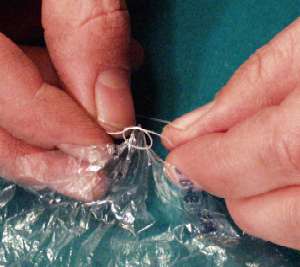
1. tie a slipknott (or even
simple overhand) close to end of shroud line
2. pinching a corner of
the chute to make a little 1/4" spike
3. slide slip knott over
spike and pull tight (if used an overhand knott in step 1, then
tie a second overhand to form a square knott)
4. attach other end of shroud
line to adjacent corner using same method.
5. repeat for other two
lines
e. Put finger through the three shroud line
loops and pull on the apex of the chute
so all lines are taught
and straight. Then tie an overhand knott in the
end of the combined
shroud lines to form a 1/2" loop.
f. Tie shock cord to nose cone using bowline
or square knott leaving 1/2" diameter
loop so knott does
not get pinched along side of nosecone and to provide a
mounting location
for the chute
g. Attach chute to shock cord by feeding the
shroud line loop through the
shockcord/nosecone
attachment loop, then feed the chute through its own shroud
line loop, gently
pull tight while ensuring all lines are straight.
Stability testing:
Before launching this rocket, make sure that it will be stable
so it doesn't fly into people.
This design has been well tested and if the instructions are
followed exactly it will be stable.
Here's the process to check stability if you've made any alterations
to the design, or just to be sure:
1. Load engine and pack chute according to "Preparation
for Launch" instructions below
2. Find the Center of Gravity (cg) point of the rocket
by balancing it on a pencil or
other thin object.
Mark this point on the body tube with a pencil.
3. Tie a 6' piece of string to the rocket at the cg point
and secure it with a piece
of tape.
4. Twirl the string and rocket over your head and verify
that it flies "pointy end
first". Purposely
try to start swinging with the rocket pointed backwards or
sideways and verify that
it quickly rotates to a nose-first attitude.
5. If the rocket is not stable, it will require larger
fins, or fins angled further
aft. There is not
a convinient way to add nose weight to this type of design.
(although you could try
making a nosecone from the pen cap, which would add
weight to the nose but hurt
performance.
Preparation for Launch:
1. Load engine
a. Remove engine retainer clip
b. Install MicroMaxx motor (verifying it is
nozel end down), until recessed past retainer clip holes.
c. Reinstall engine retainer clip
2. Insert recovery protection wadding. two pea-sized balls
of cellulose or Estes
tissue. Use straightened
large paper clip as a ram-rod but do not push all the
way into the motor, just until
wadding contacts motor thrust ring.
3. Pack chute (Note: do this immediately prior to launch.
A chute packed for several
hours may not open as reliably):
Theory: It is very difficult to pack a large chute
into a small tube and have it
open reliably. The technique used here depends
on the chute being constructed of
a material that will not stick to itself when tightly
compressed (which most
plastics do). Another problem can arise with
a very lightweight rocket not
developing enough descent rate to cause the chute
to inflate. This packing
technique uses the force of the ejection (which
is disproportionately strong for
MicroMaxx motors) to blow the nosecone, shock cord,
and shoud lines out first so
they are stretched out. The canopy is then
blasted out mouth- first so it is
forcefully inflated as it exits the body tube. This
technique has worked flawlessly,
resulting in instant openings.
a. Talc both sides of chute
b. "Flake" (the skydiving term) individual
pannels of chute so it is stretched out
with all lines taut
in center and the material neatly arranged.
c. Fold peak 1" of chute back on itself so
the chute will be short enough to fit
the body tube.
d. While keeping taut, gently sqeeze sides
of chute into a thin cylinder shape.
Do not fold
or roll, just sqeeze.
e. Insert part of shock cord into tube, leaving
enough outside so it is even with
the chute lines and
chute.
f. Insert chute into tube, apex/peak first,
gently sliding it in. Do not force or
cause chute to kink.
Periodically tug on the lines to ensure that the chute
is able to slide back
out easily.
g. Insert a pea sized bit of wadding and use
straightened paperclip to push chute
down far enough to
leave room for lines and nose cone.
h. Make 3/4" S-folds in the lines and shock
cord together between thumb and finger,
then slide into tube.
Insert a small piece of wadding to keep them from falling
out. This is
difficult, especially since Kevlar shock cord is springy.
i. Insert nose cone, making sure to keep from
pinching lines. Check that nosecone
easily slides back
out.
j. Install cap on pen to hold nosecone in
place until ready to launch. (cap will be
removed once rocket
is positioned on the pad)
4. Place rocket on pad:
a. Ensure that safety key is removed from
launch controller and install new
ignitor on MicroMaxx
pad.
b. Place over launch rod on MicroMaxx pad.
c. Remove pen cap
d. Ensure that ignitor slides up into engine
nozel without contacting the motor
retainer clip, which
could short out the ignitor
5. Launch
a. Check that area is clear of people/pets
b. Insert launch key, check for audible continuity
tone
c. 5 4 3 2 1 Launch
d. Rocket will climb about 50-100' then eject
the nosecone and parachute. Because
of the way the chute
is packed, it should open immediately during the ejection
process.
e. Recover the rocket. Note, the engine and
retainer clip may be hot.
f. After allowing 1 minute to cool, remove
the engine retainer clip and insert
the staightened paper
clip from the top end to push the spent motor casing out
of the rocket.
6. Store:
a. Store rocket with chute unpacked and spent
motor removed
b. Clean any exhaust or ejection residue from
the inside of the body tube using a
Q-tip and rubbing
alcohol.
c. Wrap the rocket and chute up in a paper
towel and store inside of a section of
cardboard paper towel
tube or small box.
Build more with different designs. Make sure to test them for stability using the twirling method before launching a new design.
Future Plans:
This project was so successful that I plan to develop other designs
around this concept.
1. Bic(R) Corporal
2. Bic(R) Mercury Redstone
3. Bic(R) Saturn IB (with clustered motors)
4. Bic(R) Saturn V (with clustered motors)
5. Bic(R) Ariane (with drop-off
boosters)
"Bic" and "Round Stic" are registered trademarks of the MM Bic Corporation, Milford, CT. Bic Corporation does not own or market these rockets, their name is used purely to accent the source of some of the rocket's components.
Designs copyright (c) 2000 by Jeffrey P. Hove, all rights reserved. Non-commercial use granted provided credit is given and this web page is linked to any on-line display of rockets derived from these techniques. I reserve exclusive rights to negotiate with Bic Corporation regarding advertising use of the Bic rocket idea.
Back to Jeff's Rockets Page
Back to Jeff's Home Page
My wife Luda's real estate site, www.ludasrealestate.com